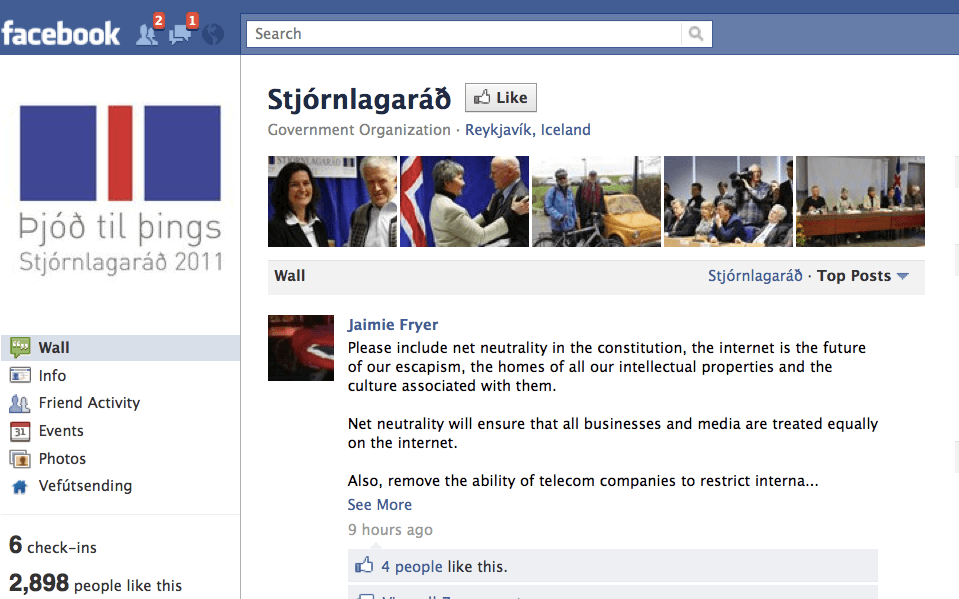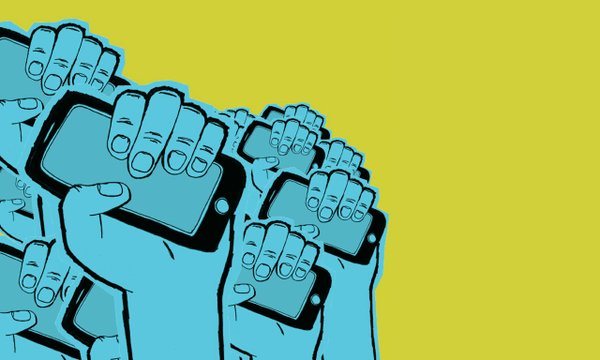Let’s crowdsource the Constitution!

Could crowdsourcing shake up the future of legislation? Lessons from the failed crowdsourcing attempt in Iceland.

Did you know that crowdsourcing is more than one thousand years old? Just think about the direct democracy of Athens developed around the fifth century B.C. As an example, once a year citizens were encouraged to participate in the process called ostracism. Through a formal procedure, anyone could submit a name of a politician who they believed posed a threat to the state. Two months later, anyone could vote, using ostrakas (or pottery shards) in lieu of today’s smartphones, in favor or against exiling given politician.
The term democracy is derived from the Greek words δῆμος (dêmos) “people” and κράτος (krátos) “rule.” The concept of the “rule of the people” very much reflects what a crowdsourcing is at its core. It is based on the idea of empowering people and providing them the venue to express their opinions. While businesses are increasingly reaping the benefits of crowdsourcing, whether finding innovative ideas internally or externally, it is interesting to consider applications of this concept in organizations that have traditionally been more insulated from technological advances; the government is a great example.
Could crowdsourcing be applied to tackle complex decisions at the national level?
Icelanders attempted to resurrect the idea of democracy in its pure form. The rewriting of the constitution in Iceland between 2010 and 2013 through the use of crowdsourcing was an unprecedented event on a global scale. The idea was a consequence of a general distrust towards political parties in Iceland following the disastrous effects of the collapse of the country’s financial system in 2008.
The Icelandic constitutional approach was based on three steps: i) selecting the National Forum comprised of 950 quasi-randomly selected citizens; ii) organizing an Assembly of 25 constitutional drafters with diverse professional backgrounds, notably excluding politicians; and iii) soliciting feedback on 12 successive drafts from the citizens through social media, including Twitter and Facebook (see an example below), as well as email and mail. While the resulting proposal was approved in a 2012 referendum by two-thirds of voters, it did not pass through Parliament.
Why the Icelandic crowdsourcing initiative failed?
- Poor planning: The process felt rushed and improvised. While there was a lot of enthusiasm for the idea, there was also a lack of direction and confusion among citizens as to the extent of their involvement.
- Questionable procedural design: Insufficient planning led to some dubious procedural choices that opened the opportunity for criticism and undermined the validity of this approach.
- Mismanagement of expectations: It was unclear what would happen once the draft is completed. Would the Parliament be obliged to vote on it?
- Lack of proper resources: The Constitutional Assembly was overwhelmed by the amount of data. It lacked sufficient infrastructure and manpower to properly process and respond to suggestions.
- Lack of focus / legal complexity: The task of drafting legal documents requires skills and training to assure quality that is at par with international standards. While the Assembly managed to draft the constitution, the text still needed to be improved by experts.
- Ignored the incumbent: The crowdsourcing process ignored the voice of legally elected representatives. As a result, none of the parties was supportive and most simply ignored it altogether. Yet it was the incumbent (i.e., the Parliament) who ultimately was the gatekeeper (i.e., voting in the Parliament).
How could legislators and governmental organizations benefit from crowdsourcing while avoiding potential pitfalls that marred the bold Icelandic experiment?
- Plan, plan, plan: The success of crowdsourcing hinges on user participation. Create user engagement. The rules need to be clear and the process seamless.
- Develop transparent procedures: Be clear what are the next steps. Make sure the campaign complies with current laws, not to risk any invalidity claims.
- Data processing: Assure that the organization can deploy trained resources to manage the process. Have a solid analytics approach in place before the launch.
- Focus: Be realistic about the scope. Aim for quality responses to a limited number of key issues.
- Ideas screening: Structured discussion with clear expectations from participants and check points by experts along the way.
- Incumbents: Use the process to aid rather than circumvent legally elected officials, if they are the gatekeepers; it should be a partnership not a competition.
- Timing: Decide on a realistic timeline. Provide real-time feedback.
- Minorities: Avoid populism, i.e., the loudest voice; assure there is a mechanism to consider minority rights.
While the effort to implement the crowdsourced constitution ultimately failed, Iceland created a precedent on a global scale and disrupted how citizens and politicians approach democracy. Iceland opened the discussion about how modern business practices can be applied in the context of government to improve national governance and policymaking, and to re-engage citizens in national matters.





I think there is some validity to the idea, it just seems to be a huge logistical nightmare. You need to communicate to the citizens what their role is, engage in a back and forth to ensure people do not put in questionable policies (there are legitimate reasons why some people refuse to back pure proportional representation and why multi-member districts are not necessarily the best methods of representation available, but that’s another blog post), and so much more. It is actually surprising it got that far.
The main problem with this, and the main problem with innovation in general, is that it is hard to explain to the current incumbents why you should get a voice, especially if it could mean the end of your business. I understand the point of the process was to keep the politicians out, but as you say there is no chance of that happening barring a truly disruptive event.
True direct democracy is almost impossible in a massive country, even one as small as Iceland. It is just difficult to coordinate a large number of people. PBS claims there were only 40,000 people with the right to vote in 5th century Athens (http://www.pbs.org/empires/thegreeks/educational/lesson1.html), whereas about 240,000 Icelanders voted in the last election. If a country can successfully pull off direct democracy with a bigger base than 50,000 people, I will be impressed. Otherwise, I think Switzerland is the best example of crowdsourcing legislation that we have.
This brings to mind an interesting proposal for ‘democracy by statistically valid sample’ — http://www.wired.com/2012/05/st_essay_voting/
The argument goes: where topics are complex and the quality of decisions improves with depth of knowledge rather than sample size, we would be better off with a smaller number of highly-knowledgeable subjects than with a larger number of less-knowledgeable subjects (the ‘crowd’). For the US, as the article points out, we would hit statistical validity with a random sample of about 100,000 voters (out of our population of ~300M).
The idea of direct democracy, largely discussed notably by Jean-Jacques Rousseau, is established under important constraints, enabling the political system to be operational and manageable, and those are largely found today in the contemporary Switz democracy. Two of these constraints go, in my opinion, against the application of the crowdsourcing technic to the public debate, and organization of our democracies: a limited geographic scope (scrutinies are organized at the town level), and a limited number of votations in a certain period of time: without these two limits, not only the system would not be logistically manageable, but one could fear new decisions/regulations/laws would be passed without allowing the necessary time for reflexion before passing a law that is sustainable in time and benefiting to the whole society. The sensational, emotional, instantaneous aspect of social media would indeed not allow this pattern. Finally, crowdsourcing laws would prevent a key mechanism for the well-functioning of every society (even the most democratic ones), being the reason of State. No one wonders then why most societies have instead chosen a representative political system…
Thanks for posting this about this topic! I had no idea this happened, but I guess if it were to happen anywhere, it would be in Iceland.
In my opinion, democracy is crowdsourcing; therefore, what Iceland did was just further experiment within the realm of democracy. Quasi-randomly selecting 950 citizens to form a National Forum is a nice thought, but it is not that much different from how many democratic countries today select their national assemblies. Yes, perhaps the citizens in the National Forum are less susceptible to capture by special interests, but an ideal democracy would pass laws to prevent this from happening.
It is also worth pointing out that there already is crowdsourcing in many other countries through ballot initiatives. For example, many states in the United States (Washington, Oregon, California, etc.) allow citizens to write state constitutional amendments and other laws, and if enough signatures are gathered the entire state will vote.
The fact that Iceland’s process excluded the incumbent politicians from the drafting process but ultimately relied on them for approval, reminds me of the part of Clay Christensen’s disruption theory that disruptive innovations (in this case crowdsourcing political and legal documents) require disruptive channels in order to be successfully implemented. It makes sense that the politicians ultimately blocked the new constitution, as it was disruptive and threatening to their core “business” (drafting laws). If other countries or governments wish to conduct similar experiments, they would be wise to make sure the entire channel is aligned.